Are you thinking about giving your home a warm, colorful, and cozy feel? Traditional Mexican designs might be just what you’re looking for.
I love how this style brings together bold colors, handmade touches, natural textures, and a deep connection to culture.
You’ll often find clay tiles, woven blankets, painted pottery, and rustic wood furniture, each piece full of charm and history.
What I appreciate most is how easy it is to blend these elements into your style without it feeling too busy or overwhelming.
In this guide, I’ll explain everything you need to know to create a traditional Mexican interior.
From colors and fabrics to furniture and décor, you’ll find simple, inspiring ideas to make your home feel warm, welcoming, and full of personality.
Understanding Traditional Mexican Design
Traditional Mexican interior design is full of color, warmth, and handmade charm.
It comes from a mix of Indigenous and Spanish cultures, with strong ties to nature, family, and tradition.
You’ll often see bright colors, clay tiles, wooden furniture, and colorful blankets or rugs that share stories of the past. Everything has meaning and feels personal.
What makes this style stand out is how it brings joy and comfort into a home. Mexican design can add life and personality even to modern spaces.
It doesn’t have to be all or nothing; you can mix a few key pieces, like a colorful pillow or a tile table, and still get that cozy, inviting feeling.
That’s why so many people love this look. It makes a home feel real, warm, and full of heart.
Features of a Traditional Mexican House
Traditional Mexican homes are known for their bold colors, natural materials, and design details that reflect the country’s deep cultural background.
1. Thick Adobe Walls

Many traditional Mexican houses have thick adobe walls made from sun-dried clay, sand, and straw bricks. These walls keep the inside cool during the day and warm at night.
Their thickness also makes the structure strong and gives it a rough, natural look. Adobe is a smart and earth-friendly way to build, using materials found nearby.
It’s been used in Mexico for hundreds of years, especially in hot and dry areas where keeping temperatures steady is important.
2. Arched Doorways and Windows
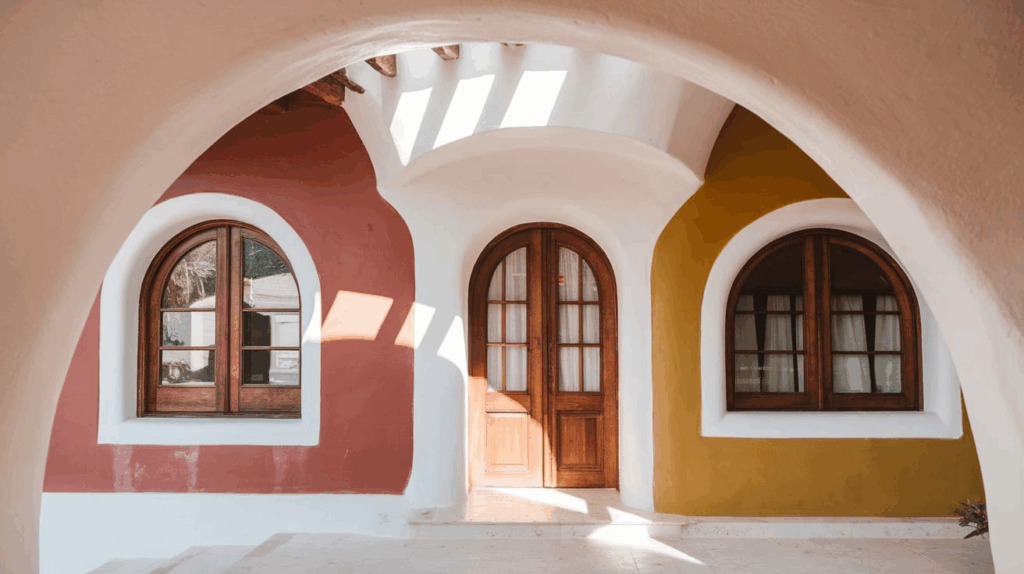
I’ve always loved how arches give Mexican homes their unique charm, reflecting Spanish influence. I used rounded doorways and windows to add style and a softer look to the structure.
Arches also help spread out weight, making bigger openings possible and letting in more light and air.
Arches are useful and meaningful, often displaying a mix of native and European design ideas.
3. Colorful Talavera Tile Work
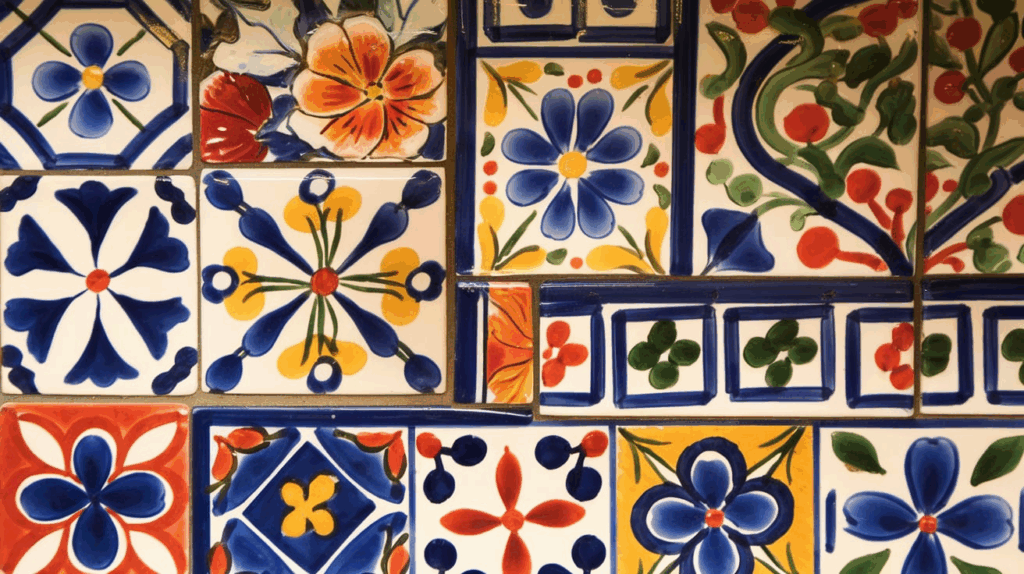
Talavera tiles are bright, hand-painted tiles known for their colorful patterns. They come from Puebla, Mexico, and are used in kitchens, bathrooms, stairs, and outside walls.
These tiles bring energy and beauty to the home, showing off Mexico’s strong art traditions. Each tile is a little different, giving the house a personal and handmade look.
Using these tiles not only makes the home look lively but also honors local craftspeople.
4. Central Courtyards (Patios)
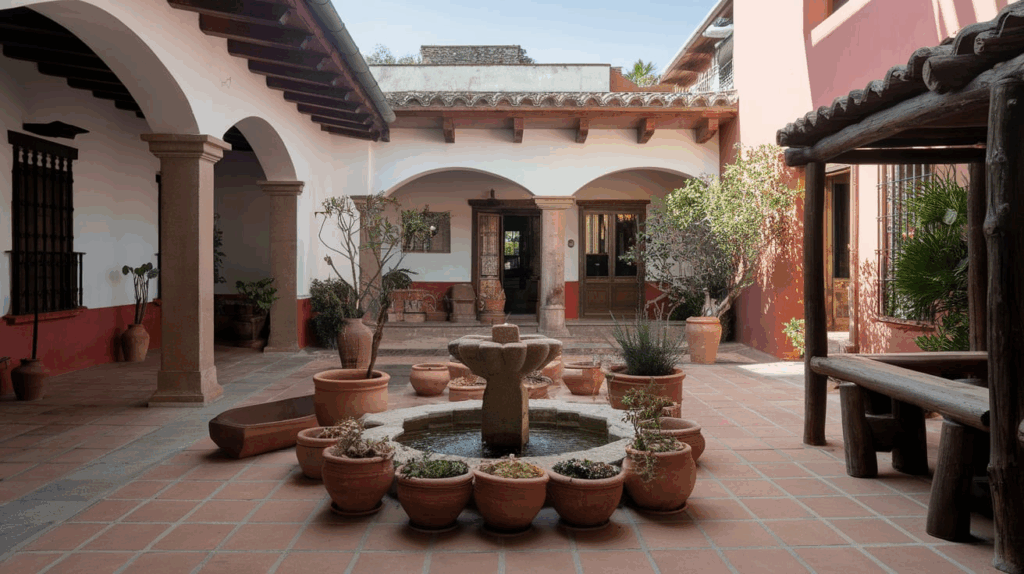
A courtyard or patio in the middle of the house is a key part of many traditional Mexican homes. This open space is often used to relax, gather with family, or enjoy a bit of fresh air.
Courtyards usually have fountains, green plants, and places to sit, making them calm and peaceful.
This setup helps with light and airflow, which is really helpful in warm places. It also shows how Mexican homes mix indoor and outdoor living.
5. Exposed Wooden Ceiling Beams (Vigas)
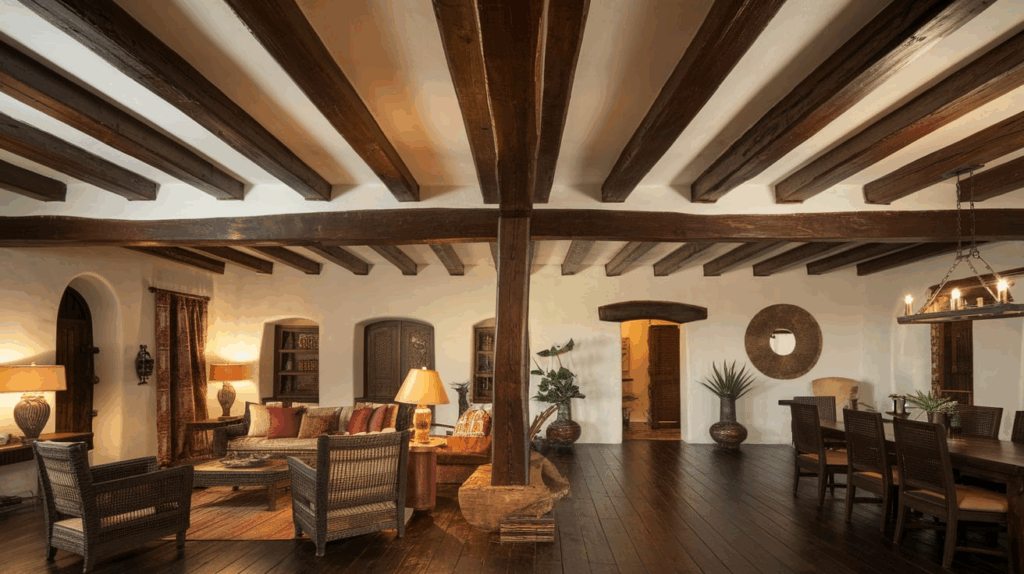
You’ll often see wooden beams, called vigas, in the ceilings of Mexican homes. These beams are made from local wood like pine and give the space a natural, homey feel.
Sometimes, the beams extend past the walls to support porches. I love how vigas showcase the natural materials and building methods of Mexican design.
Seeing the beams reminds people of the effort and care that went into making the home.
6. Terracotta Tile Floors
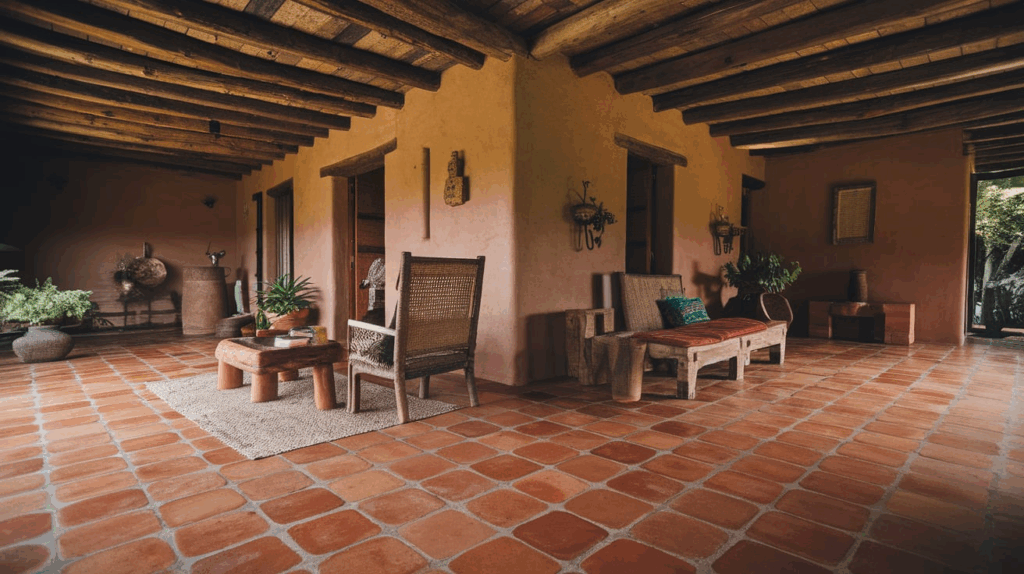
Floors in Mexican homes are often made with terracotta tiles, which come from natural clay. These tiles are a reddish-brown color that works well with the other colors in the house.
They’re tough, easy to take care of, and feel cool on your feet, great for warm weather. Since each tile is a bit different, they add texture and a classic look.
Terracotta floors reflect a strong link to nature and a love for simple, lasting materials.
All these parts come together to make homes that are comfortable, useful, and full of cultural meaning. Using these ideas can help bring the warmth and style of traditional Mexican homes into modern spaces.
Elements to Create a Traditional Mexican Interior
If you’re looking forward to giving your home a traditional Mexican touch, then here are all the simple ways in which you can add the beauty of traditional Mexican houses to your home:
1. Embracing Vibrant Color Palettes
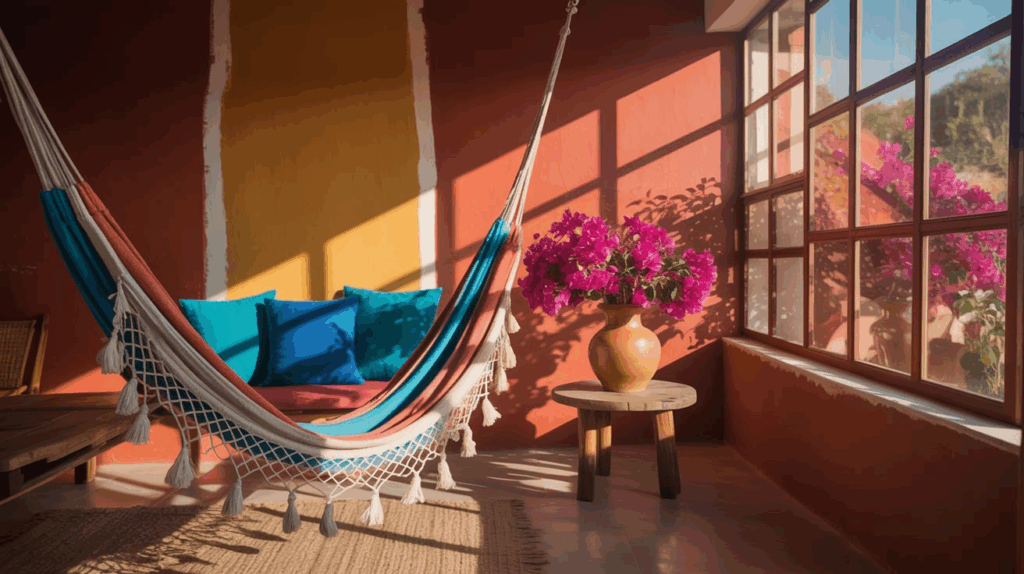
Color plays a huge role in traditional Mexican style – it’s bold, joyful, and full of life.
- Start with warm, earthy tones: Terracotta, mustard yellow, and burnt orange create a cozy, grounded feel inspired by the sun and soil.
- Let color tell a story: These shades aren’t just pretty, they reflect history, nature, and cultural roots.
- Add bold accent colors: Use turquoise, cobalt blue, or magenta on pillows, pottery, rugs, or wall art to make the space pop.
- Have fun and trust your instincts: You don’t need to be a designer, just go with what feels joyful and welcoming.
- Mix warm and cool shades: Pair red with blue or green with orange for balance and personality that feels both lively and natural.
2. Incorporating Natural Materials
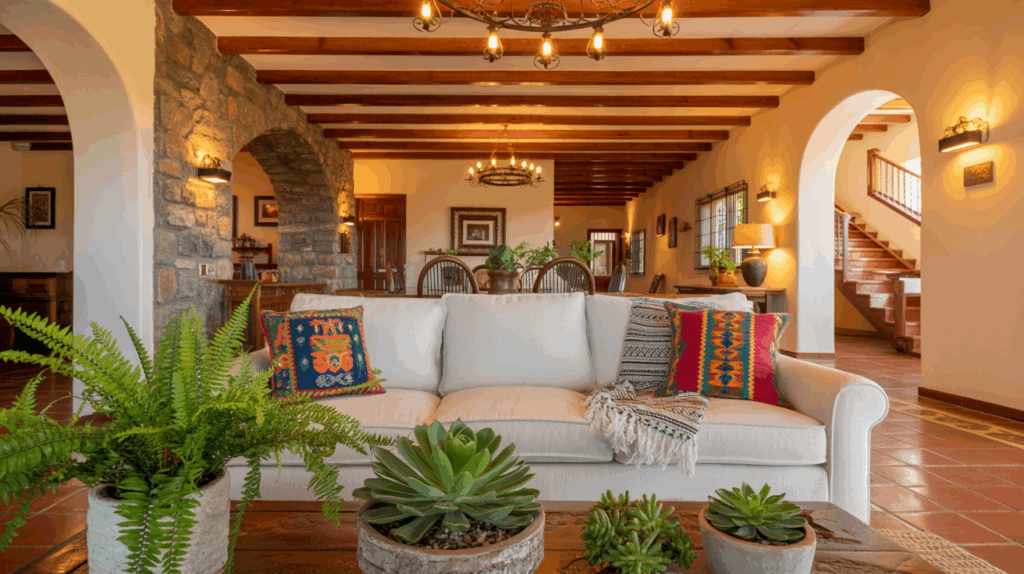
Natural elements are a key part of traditional Mexican design. They help create warm, grounded spaces that feel connected to nature.
- Use wood and stone for structure: Look for exposed wooden ceiling beams or thick wooden doors with iron or metal accents.
- Go for rustic finishes: Wood in Mexican homes often has a raw, slightly rough texture that adds to the old-world charm.
- Include stone in surfaces: Stone shows up in walls, floors, or fireplace surrounds, offering an earthy, timeless feel.
- Add terracotta tiles: These reddish-brown tiles are used for floors, stairs, backsplashes, and bathroom walls—and they add instant warmth.
- Embrace imperfections: Terracotta’s handmade look, with its subtle flaws, gives each room a sense of history and character.
3. Utilizing Traditional Textiles and Patterns
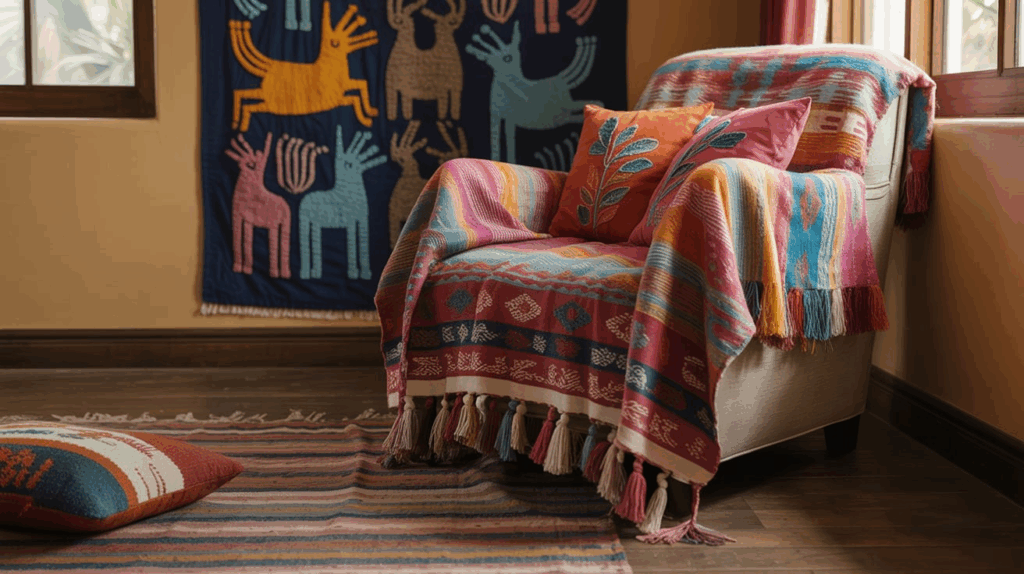
Traditional Mexican textiles bring color, story, and heritage into any home.
- Celebrate cultural craftsmanship: These vibrant fabrics are often handmade using age-old techniques passed down through generations.
- Add warmth with bold colors and patterns: Rich hues and detailed designs instantly bring character to any space.
- Use handwoven pieces with purpose: Blankets, table runners, and rugs crafted by Zapotec and Otomi artisans offer both function and tradition.
- Embrace Otomi embroidery: These intricate designs feature bright animals and plants, adding visual storytelling to pillows and wall hangings.
- Layer materials for texture: Combine cotton, wool, and embroidered fabrics to create a cozy, dimensional look.
- Honor the heritage behind the décor: Incorporating these textiles not only enhances your space but also supports and celebrates cultural legacy.
4. Showing Mexican Folk Art and Handicrafts

Mexican folk art is vibrant, symbolic, and full of heart. Adding just a few handmade pieces can instantly bring warmth, meaning, and cultural depth to your space.
- Display Talavera pottery: These bright, hand-painted ceramics often feature flowers, birds, and bold patterns—great for shelves, countertops, or tile accents.
- Use Olinalá lacquerware: Hand-painted wooden boxes and trays with intricate designs are both beautiful and practical for holding jewelry, keys, or keepsakes.
- Celebrate with Day of the Dead art: Painted skulls and skeletons reflect family, remembrance, and joy, not sorrow, and add meaningful color to your décor.
- Choose a few standout pieces: Even a small collection of handmade folk art can make your home feel more personal and authentically rooted in tradition.
5. Designing with Architectural Elements
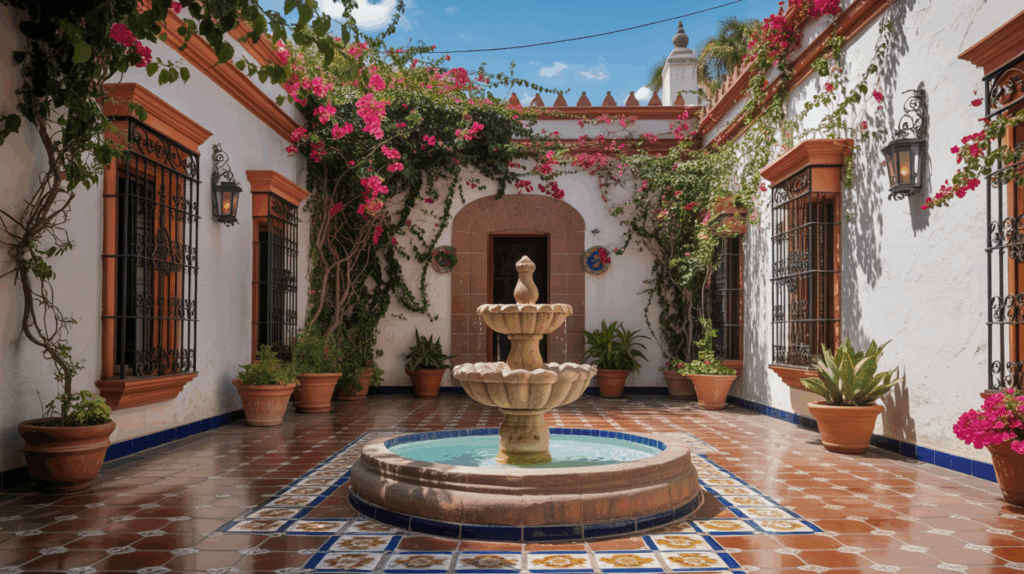
Bringing the warmth and beauty of Mexican style into your space is all about thoughtful details, natural materials, and lively color.
- Arched features for softness: Arched doorways add charm and openness. If remodeling isn’t an option, try rounded mirrors, curved furniture, or arched wall decor for a similar effect.
- Make use of outdoor spaces: Courtyards and patios are central to Mexican homes—perfect spots for relaxing or gathering with family.
- Add traditional outdoor elements: Terracotta tiles, bold plants, rustic wood furniture, and colorful textiles help create that authentic outdoor feel.
- Transform small spaces: Even a small porch or balcony can embrace the style with potted plants, woven rugs, and ambient lighting like string lights.
- Use a rich color palette: Combine earthy tones – clay, mustard, sand – with vibrant pops like turquoise, red, or cobalt blue.
- Choose natural materials: Wood, clay, and wrought iron add warmth and a grounded, handcrafted look.
6. Selecting Authentic Furniture
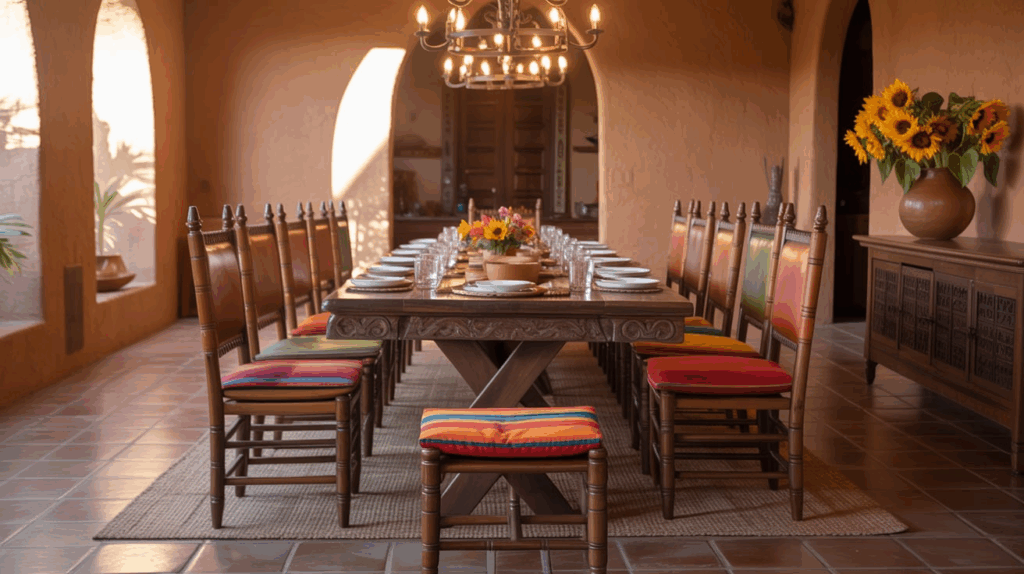
Mexican-style furniture blends rustic charm with deep cultural roots. It’s handcrafted, full of personality, and built to last.
- Made from solid, durable wood: Pine and mesquite are popular choices, valued for their strength, natural grain, and rich texture.
- Rustic finishes add character: Many pieces have a rough or weathered look, highlighting the beauty of natural flaws like knots or uneven tones.
- Functional, sturdy designs: Look for classic furniture like heavy tables, benches, armoires, and trunks—built for everyday use and lasting beauty.
- Hand-forged iron accents: Hinges, handles, and decorative details often feature black or aged iron, adding craftsmanship and contrast.
- Decorative carving: Floral designs, patterns, and traditional symbols are commonly carved into the wood, reflecting the artisan’s heritage.
- Bold, colorful touches: Painted surfaces, ceramic tile inlays, or bright textiles help balance raw wood with joyful, handmade charm.
7. Incorporating Indoor Plants
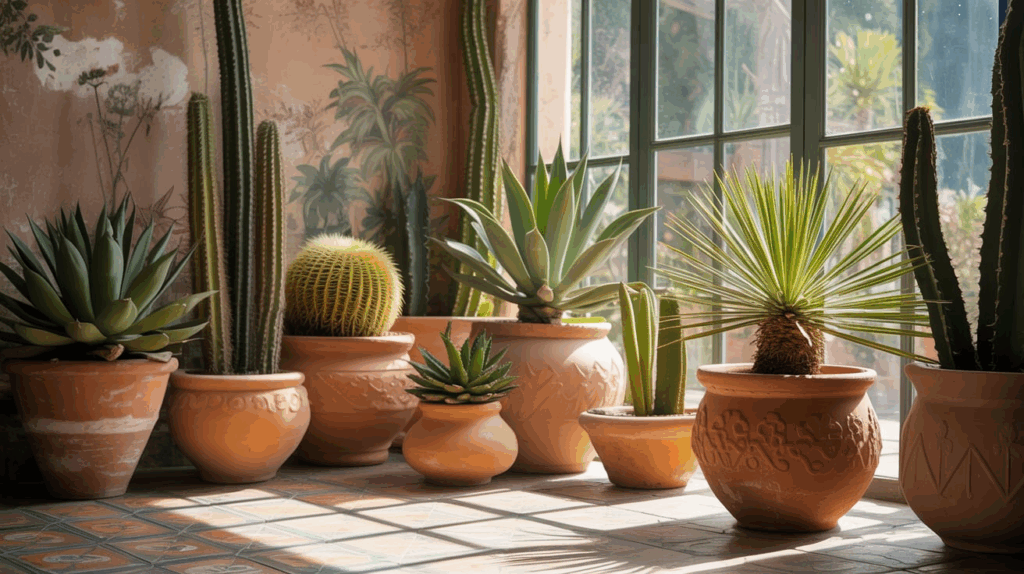
Plants are a natural way to bring life and warmth into your space – and they’ve always had a special place in Mexican home design.
- Start with cacti and succulents: These low-maintenance plants come in all shapes and sizes and thrive with little water.
- Highlight texture and form: Their bold shapes and textured leaves make a strong impact, even in small pots.
- Use agave and yucca for larger spaces: These tall, sculptural plants work well in corners or near sunny windows where they get plenty of light.
- Play with pottery: Choose hand-painted pots for a splash of color, or mix plain and painted designs for a balanced look.
- Create a calm, grounded vibe: A few thoughtfully placed plants can make your space feel peaceful, earthy, and naturally beautiful.
I love how each of these elements brings warmth, culture, and personality into a space. They helped me create a home that feels both meaningful and uniquely mine.
Conclusion
Traditional Mexican interior design is all about color, warmth, and handmade beauty. It’s a style that brings together nature, culture, and comfort in a way that feels honest and inviting.
From bold colors and natural materials to embroidered fabrics and clay tiles, every piece has something to share.
The best part? You don’t need to change your whole house to enjoy this style. Start small with a woven blanket, a few bright pillows, or a handmade pot. Mix and match as you go.
There are no strict rules; choose what feels right and makes your home feel more like “you.”
Even if you add just a little, these pieces can turn any space into something real and full of feeling. So enjoy the process, and let your home reflect some of the warmth and heart found in Mexican style.

